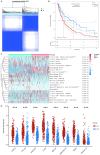Identification of immune-related biomarkers associated with tumorigenesis and prognosis in skin cutaneous melanoma
- PMID: 35530289
- PMCID: PMC9077068
Identification of immune-related biomarkers associated with tumorigenesis and prognosis in skin cutaneous melanoma
Abstract
Skin cutaneous melanoma (SKCM) is one of the most malignant and aggressive forms of cancer. Investigating the mechanisms of carcinogenesis further could lead to the discovery of prognostic biomarkers that could be used to guide cancer treatment. In this study, we conducted integrative bioinformatics analyses of TCGA database, STRING, cBioPortal, TRRUST, The Human Protein Atlas, and DGIdb to determine which hub genes contributed to tumor progression and the cancer-associated immunology of SKCM. The results show that immune-related 873 differential genes grouped SKCM samples into subtypes. The initial results showed that the optimal number of clusters was two subgroups. Further analysis showed that there were significant differences in survival rate and immune infiltration level between the two subgroups. Subsequently, obtaining the different genes between groups, construct PPI to screen 6 hub genes (HLA-DPA1, HLA-DPB1, HLA-DQA1, HLA-DRA, HLA-DRB1, HLA-DRB5). In total, 6 MHC class II molecules were significantly related to overall survival. We then analyzed the expression of these genes along with their mutation landscapes, transcription factor regulation, and drug regulatory networks. In summary, our study identified 6 MHC class II molecules (HLA-DPA1, HLA-DPB1, HLA-DQA1, HLA-DRA, HLA-DRB1, HLA-DRB5) as important biomarkers in the occurrence and progression of SKCM tumors. Their expression levels are closely related to prognosis and immune infiltration and can help us better understand the tumorigenesis of SKCM.
Keywords: Cutaneous melanoma; HLA; biomarker; immune; infiltration; prognosis.
AJCR Copyright © 2022.
Conflict of interest statement
None.
Figures









References
-
- Schadendorf D, van Akkooi ACJ, Berking C, Griewank KG, Gutzmer R, Hauschild A, Stang A, Roesch A, Ugurel S. Melanoma. Lancet. 2018;392:971–984. - PubMed
-
- Bajor DL, Mick R, Riese MJ, Huang AC, Sullivan B, Richman LP, Torigian DA, George SM, Stelekati E, Chen F, Melenhorst JJ, Lacey SF, Xu X, Wherry EJ, Gangadhar TC, Amaravadi RK, Schuchter LM, Vonderheide RH. Long-term outcomes of a phase I study of agonist CD40 antibody and CTLA-4 blockade in patients with metastatic melanoma. Oncoimmunology. 2018;7:e1468956. - PMC - PubMed
LinkOut - more resources
Full Text Sources
Research Materials
